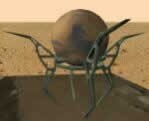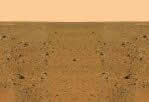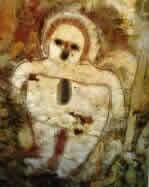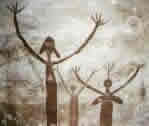| |
Mars
is the fourth planet from the sun and one of Earth's nearest neighbors.
It is also the only other planet in the solar system where humans
may one day live. Mars is smaller and colder than Earth, but is
otherwise remarkably similar. It has days and seasons, a thin
atmosphere and, quite possibly, significant reserves of water
buried as ice beneath the surface. there is even a chance that
Mars once played a host to simple life forms, and that fossilized
remains of long extinct creatures are buried there.
|
| Fossil
Remains |
In
1984, scientists discovered a meteorite in Antarctica which they
believe came from Mars. Inside the four-pound rock were traces
of what may be the fossilized remains of primitive, single-celled
organisms, suggesting that there was once life on Mars.
|
| Colonize
Mars ? |
The
most likely future for Mars from a human point of view is a mining
colony, supplying us with minerals that have been exhausted on
earth. Mars is rich in minerals - especially iron and aluminum,
which even in the 24th century, will still be the basis of engineering
and construction. Other elements required could be shipped from
other sources such as Mercury or the Asteroid Belt.
|
| A
Cold Rocky Desert |
Of
all the planets in the solar system, Mars is almost certainly
the most like ours. Its axis is tilted like the Earth's, which
gives it seasons. Mars has a relatively warm summer, when temperatures
in the southern hemisphere can reach 68 degrees F, but a long
cold winter that sees them plunge to -284 degrees F.
|
Over
4 billion years ago, Mars was covered with massive volcanoes -
just like the Earth - and possibly had some surface water, which
gathered in flash floods, carving water channels into the surface.
Like the Earth, Mars has a cloudy atmosphere; although the Martian
"air" is much thinner, and the wispy clouds are made
of carbon dioxide rather than water vapor.
|
So,
despite its many similarities to Earth, Mars is a far from hospitable
place. If you had landed there without a space suit, not only
would you suffocate but, due to the much lower atmospheric pressure,
your blood would boil within minutes.
|
| Dust
Storms |
Apart
from the lack of oxygen and low atmospheric pressure, you would
have to withstand the continuous winds that blow across the Martian
surface at speeds of over 125 miles per hour, whipping up giant
clouds of fine orange-brown dust in their wake. Its is the dust
that has earned Mars the nickname "The Red Planet",
although "Rust Planet" might be more appropriate, since
the color is explained by the big proportion of iron in the planet's
rocks - on average, almost twice as much as on Earth. Mars is
also very dry and cold. Even on a warm summer's day the ground
rarely get above freezing point, and on a winter mornings the
rocks are often coated with a fine layer of carbon dioxide "frost".
|
The
two tiny moons of Mars, Phobos and Deimos, race around the planet
in about 8 hours and 30 hours respectively. They are thought to
be asteroids that strayed too close to the planet in the distant
past and were captured by its gravity. If Phobos, the closer of
the two, maintains its present orbit, it is likely to crash into
Mars in about 100,000 years' time. there is also some evidence
to suggest that the planet has suffered similar collisions in
the past.
|
|
|










